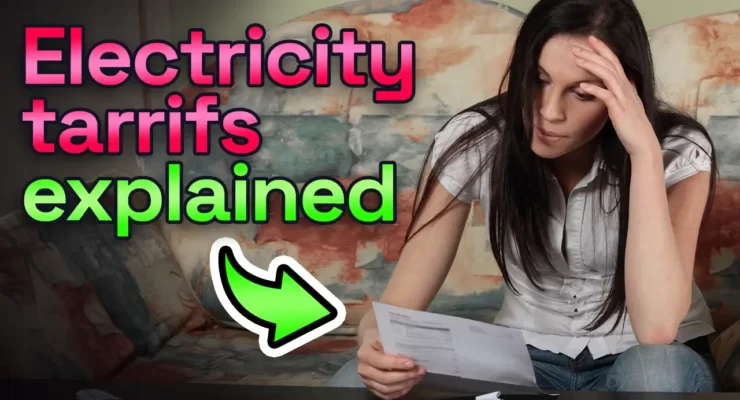Fast read
Electricity tariffs determine billing for energy usage, including general tariffs, time-of-use plans, controlled load rates, and feed-in tariffs.
General tariffs charge a flat rate with added daily energy supply charges. Time-of-use tariffs vary rates based on peak, shoulder, and off-peak periods.
Controlled load rates apply to specific appliances during off-peak hours. Feed-in tariffs allow solar panel owners to sell surplus energy back to the grid.
Understanding these options helps optimize energy savings and reduce costs, requiring evaluation of individual needs and staying informed about regulatory changes.
Understanding these options helps optimize energy savings and reduce costs, requiring evaluation of individual needs and staying informed about regulatory changes.
Electricity Tariffs Explained
Electricity tariffs are crucial in determining how consumers are billed for electricity usage. Each option offers distinct advantages and considerations, from general tariffs to time-of-use electricity plans and controlled load rates. In this detailed guide, we will explore different types of electricity tariffs to help you understand energy billing better.
1. General Electricity Tariff
The general tariff is the most common pricing structure offered by energy retailers. It is also known as the single or flat rate tariff. This pricing structure is simple and easy to understand.
With this electricity tariff, consumers pay the same rate for electricity no matter when they use it, whether it’s day or night. However, some providers may offer tiered pricing, where different rates apply to specified usage blocks.
One of the key components of the general tariff is the Daily Supply Charge, which covers the cost of maintaining access to the electricity grid. This fee is charged no matter how much energy is used. It has gone up a lot lately because of maintenance and upgrades to the network.
The general electricity tariff is easy to understand and predict for electricity billing. However, it may not be the most cost-effective choice for everyone. This is especially true for those who use different amounts of energy or are looking to reduce their energy expenses.
2. Time of Use (ToU) Electricity Tariff
The Time of Use tariff introduces a dynamic pricing structure based on the time of day when electricity is consumed. This electricity tariff is divided into peak, shoulder, and off-peak periods, each with corresponding rates.
Peak periods are when electricity demand is high, usually on weekday evenings. Shoulder periods are times of medium demand, like weekday mornings and weekends. During late nights and early mornings, off-peak periods represent low electricity demand.
By aligning energy usage with off-peak periods, consumers can use lower electricity rates to reduce their energy costs. Time-of-use electricity tariffs encourage consumers to do energy-intensive tasks like laundry or dishwashing during off-peak hours. This helps to use energy more efficiently and manage the grid better.
It’s important to think about if your lifestyle and energy habits match up with peak, shoulder, and off-peak times. For households with significant energy consumption during peak hours, a time-of-use tariff may result in higher overall costs than a general tariff.

3. Controlled Load Rate
The Controlled Load Rate, also known as off-peak electricity, caters to specific appliances with low-demand usage patterns, such as water heaters and hydronic heating systems. This electricity tariff lets the energy retailer decide when certain appliances use electricity. They typically turn these appliances on during times when demand on the grid is low, like off-peak hours.
Consumers save money on electricity when using appliances with controlled loads, making it a great way to lower energy costs. Consumers can save money on electricity by using energy-intensive appliances like hot water systems during off-peak hours. This means using these appliances when electricity demand is lower, usually during the night or early morning. By doing this, consumers can still meet their household needs while reducing their electricity rates.
4. Feed-in Tariff (FIT)
The Feed-in Tariff (FIT) is a critical component of the energy landscape for consumers with solar panel energy systems. It enables homeowners to generate surplus electricity from their solar panels and feed it back into the grid. In return, consumers receive credits or payments from their energy retailer for the electricity exported to the grid.
FIT rates may vary based on government policies, grid conditions, and supply and demand dynamics of renewable energy sources. Consumers may get higher FIT rates when electricity demand is high or when the energy provider can’t generate enough electricity. This can happen during peak times of usage. It can also occur when there are issues with the energy provider’s ability to meet demand.
The FIT encourages solar energy generation and helps increase the use of renewable energy sources. However, it has also led to discussions about fair payment for solar energy producers. Some people say that FIT rates don’t show the real value of solar energy well. This has led to talks about changing electricity tariffs and making sure people are paid fairly for their solar energy.
Conclusion
Electricity tariffs play a pivotal role in shaping consumer behaviour, influencing energy consumption patterns, and driving the uptake of renewable energy sources. Consumers can make better decisions about their energy usage by understanding different electricity tariff structures. This can help them save energy, cut costs, and support a more sustainable energy future.
Choosing the right energy plan for you depends on understanding your energy needs and usage habits. There are different options to consider, such as a general plan, time-based plan, controlled load rate, or feed-in tariff. Each of these plans has its own benefits and considerations.
It’s important to evaluate your energy consumption patterns before making a decision. Staying informed about new rules, government incentives, and new technologies can help individuals navigate the evolving energy landscape. This knowledge can empower people to make informed decisions about their energy usage. By staying up-to-date on these factors, individuals can make smart choices about how they use energy.
